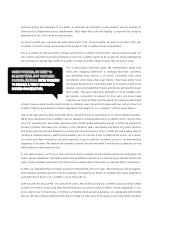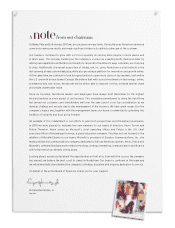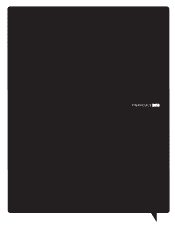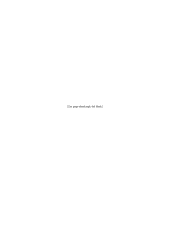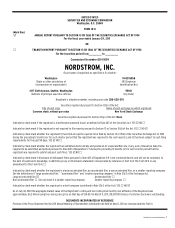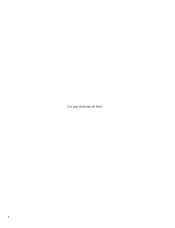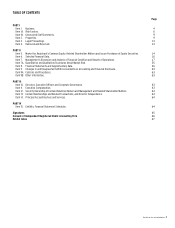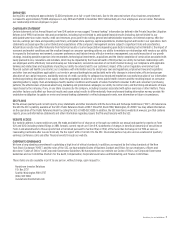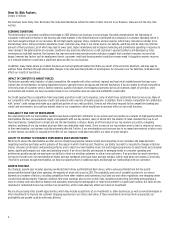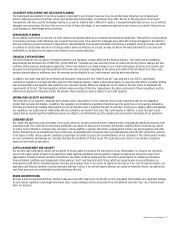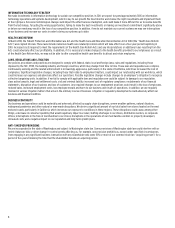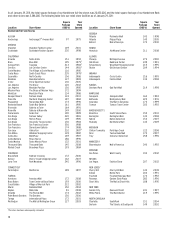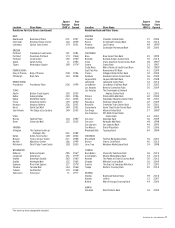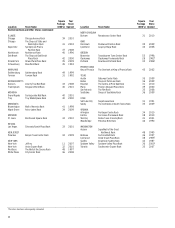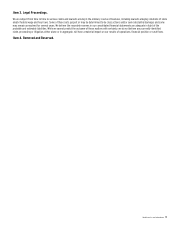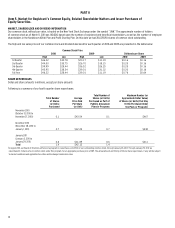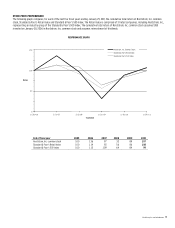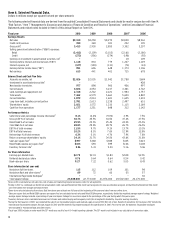Nordstrom 2010 Annual Report Download - page 14
Download and view the complete annual report
Please find page 14 of the 2010 Nordstrom annual report below. You can navigate through the pages in the report by either clicking on the pages listed below, or by using the keyword search tool below to find specific information within the annual report.6
Item 1A. Risk Factors.
Dollars in millions
Our business faces many risks. We believe the risks described below outline the items of most concern to us. However, these are not the only risks
we face.
ECONOMIC CONDITIONS
The deterioration in economic conditions that began in 2007 affected our business in several ways. Elevated unemployment, the tightening of
consumer credit and the decline in the housing and stock markets in the United States all contributed to a reduction in consumer spending, which in
turn had a negative impact on our revenues. We sell high-quality apparel, shoes, cosmetics and accessories, which many consumers consider to be
discretionary items. During economic downturns, fewer customers may shop in our stores and on our website, and those who do shop may limit the
amount of their purchases, all of which may lead to lower sales, higher markdowns and increased marketing and promotional spending in response to
lower demand. The deterioration of economic conditions also adversely affected our credit customers’ payment patterns and delinquency rates,
increasing our bad debt expense. Our business has improved and some macroeconomic indicators suggest that a modest economic recovery has
begun, however key factors such as employment levels, consumer credit and housing market conditions remain weak. A sluggish economic recovery
or a renewed downturn could have a significant adverse effect on our business.
In addition, many states where we conduct business are facing significant budget shortfalls as a result of the economic downturn, and may seek to
address those shortfalls through unfavorable changes in tax laws and interpretation of existing laws. An increase in our tax liabilities could adversely
affect our results of operations.
IMPACT OF COMPETITIVE MARKET FORCES
The fashion specialty retail industry is highly competitive. We compete with other national, regional and local retail establishments that may carry
similar lines of merchandise, including department stores, specialty stores, boutiques and Internet businesses. If we are unable to remain competitive
in the key areas of customer service, fashion newness, quality of products, the shopping experience across all channels, depth of selection, store
environment and location, we may lose market share to our competitors and our sales and profitability could suffer.
Our Credit segment faces competition from large banks and other credit card companies, some of which have substantial financial resources. Many of
our competitors offer general-purpose credit card products with a variety of loyalty programs. In addition, there is intense competition for cardholders
with “prime” credit ratings who make up a significant portion of our credit portfolio. If we do not effectively respond to the competitive banking and
credit card environment, we could lose market share to our competitors, which would have an adverse effect on our credit business.
AVAILABILITY AND COST OF MERCHANDISE
Our relationships with our merchandise vendors have been a significant contributor to our success and our position as a retailer of high-quality fashion
merchandise. We have no guaranteed supply arrangements with our key vendors, many of whom limit the number of retail channels they use to sell
their merchandise. Competition to obtain and sell this merchandise is intense. Nearly all of the brands of our top vendors are sold by competing
retailers, and many of our top vendors also have their own dedicated retail stores. If one or more of our top vendors were to limit or reduce our access
to their merchandise, our business could be adversely affected. Further, if our merchandise costs increase due to increased raw material or labor costs
or other factors, our ability to respond or the effect of our response could adversely affect our sales or gross margins.
ABILITY TO RESPOND TO CONSUMER PREFERENCES AND FASHION TRENDS
We strive to ensure the merchandise we offer and our shopping experience remain current and compelling to our customers. We make decisions
regarding inventory purchases well in advance of the season in which it will be sold. Therefore, our ability to predict or respond to changes in fashion
trends, consumer preferences and spending patterns, and to match our merchandise levels, mix and shopping experience to sales trends and consumer
tastes, significantly impacts our sales and operating results. If we do not identify and respond to emerging trends in consumer spending and
preferences quickly enough, we may harm our ability to retain our existing customers or attract new customers. If we purchase too much inventory,
we may be forced to sell our merchandise at higher average markdown levels and lower average margins, which could harm our business. Conversely,
if we fail to purchase enough merchandise, we may lose opportunities for additional sales and damage our relationships with our customers.
GROWTH STRATEGY
Our strategic growth plan includes opening new Nordstrom full-line and Nordstrom Rack stores, with 6 announced Nordstrom full-line and 18
announced Nordstrom Rack store openings, the majority of which will occur by 2012. The availability and cost of suitable locations for our stores
depends on a number of factors, including competition from other retailers and businesses, local land use and other regulations, new shopping center
construction and developers’ financial condition. New store openings also involve certain risks, including constructing, furnishing and supplying a
store in a timely and cost effective manner and accurately assessing the demographic or retail environment for a particular location. Our sales at new,
relocated or remodeled stores may not meet our projections, which could adversely affect our return on investment.
We are also pursuing other growth opportunities, which may include acquisitions of, or investments in, other businesses, as well as new technologies or
other investments to improve the customer shopping experience in our stores and online. If these investments do not perform as expected, our
profitability and growth could be adversely affected.


